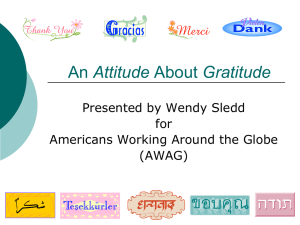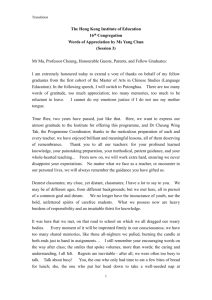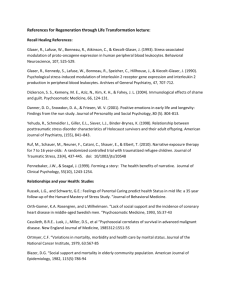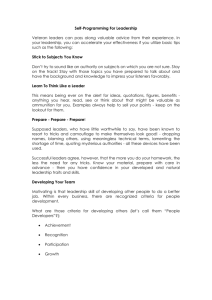IN GRATITUDE WE THRIVE!
advertisement
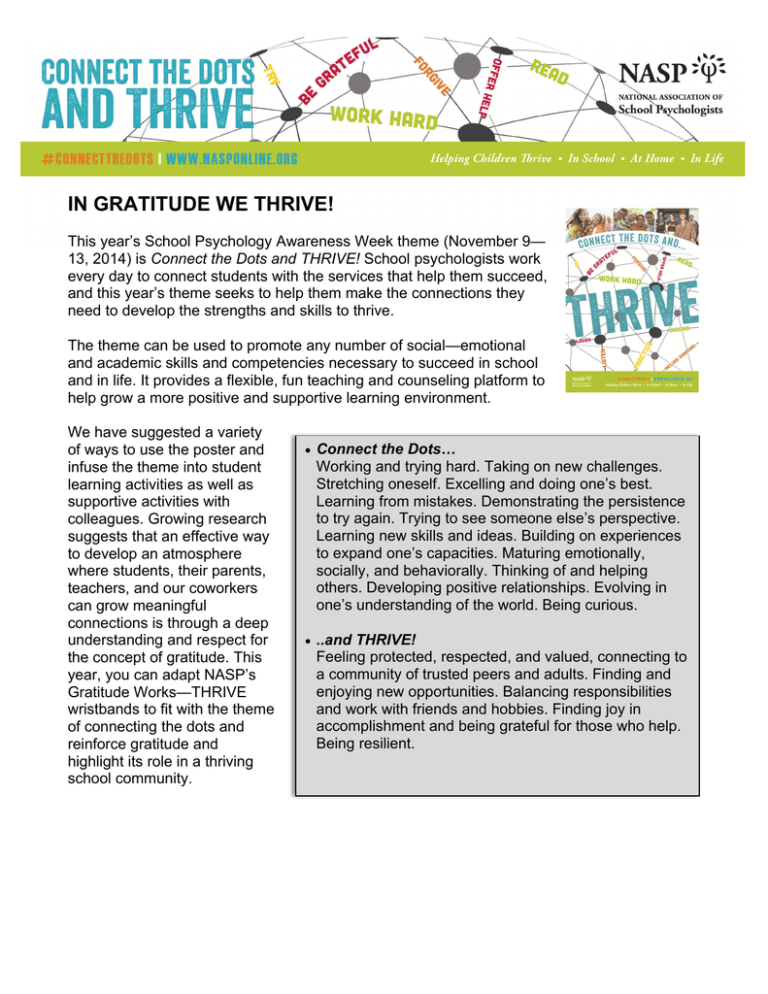
IN GRATITUDE WE THRIVE! This year’s School Psychology Awareness Week theme (November 9— 13, 2014) is Connect the Dots and THRIVE! School psychologists work every day to connect students with the services that help them succeed, and this year’s theme seeks to help them make the connections they need to develop the strengths and skills to thrive. The theme can be used to promote any number of social—emotional and academic skills and competencies necessary to succeed in school and in life. It provides a flexible, fun teaching and counseling platform to help grow a more positive and supportive learning environment. We have suggested a variety of ways to use the poster and infuse the theme into student learning activities as well as supportive activities with colleagues. Growing research suggests that an effective way to develop an atmosphere where students, their parents, teachers, and our coworkers can grow meaningful connections is through a deep understanding and respect for the concept of gratitude. This year, you can adapt NASP’s Gratitude Works—THRIVE wristbands to fit with the theme of connecting the dots and reinforce gratitude and highlight its role in a thriving school community. Connect the Dots… Working and trying hard. Taking on new challenges. Stretching oneself. Excelling and doing one’s best. Learning from mistakes. Demonstrating the persistence to try again. Trying to see someone else’s perspective. Learning new skills and ideas. Building on experiences to expand one’s capacities. Maturing emotionally, socially, and behaviorally. Thinking of and helping others. Developing positive relationships. Evolving in one’s understanding of the world. Being curious. ..and THRIVE! Feeling protected, respected, and valued, connecting to a community of trusted peers and adults. Finding and enjoying new opportunities. Balancing responsibilities and work with friends and hobbies. Finding joy in accomplishment and being grateful for those who help. Being resilient. Gratitude Works/Thrive Wristbands The new blue and green wristband is embossed with “Thrive” on one side and the phrase “Gratitude Works” on the other. The primary intent of the wristband is to recognize, through gratitude, individuals, students and staff who have made positive contributions to the school community. The contribution being recognized, the recipient, and the manner in which the bracelet is presented can be adapted to a specific school’s needs. You can work with teachers and other staff to identify objectives, behaviors, or ideas that you want to reinforce with the bracelet campaign. For instance, the campaign could reinforce specific positive behavior and supports goals, or guidelines could be more open, allowing students to more independently identify for what and to whom they are grateful. Bracelets can be given to recipients to keep or to wear for a set period of time then passed to someone else. Bracelets can be purchased in batches of 50 for $10 plus $3.50 shipping at http://www.nasponline.org/publications/promoteprofession.aspx. Connecting the Dots Print out the “dot” template below to make gratitude notes for your students or colleagues to use. These notes can be presented with the wristband to the individual and/or posted in a public area. Gratitude notes can then be arranged in a “Connect the Dots” display to highlight the actions of staff and students and reinforce how individual positive actions can create connections that help the school community thrive. Suggested Activities Below are a few general suggestions to help you plan your activities. Feel free to come up with your own ideas and remember to share what you did using the feedback survey located at http://www.nasponline.org/communications/spaw/feedback.aspx. Younger Students In elementary schools, school psychologists and teachers can express gratitude to students who are exhibiting classroom rules or behaviors, such as kindness, respect or good listening to connect how these behaviors make it easier for the whole class learn and get along. Teachers can also ask students to think about their connection to other adults in the school who have helped them thrive, and then help them write a note and present a bracelet to that person. Students can be encouraged to think broadly about people like the bus driver, school resource officer, or playground monitor. Older Students Middle and high school students can benefit by being part of the campaign leadership. You can work with specific student groups such as student government associations, sports teams, or clubs to develop the guidelines and promotional aspects of the campaign. Students can take a peer mentoring approach to recognizing peers for whom they are grateful, posting gratitude “dot” notes in designated places in the school. They could start a “Pass It On” campaign where students who receive the bracelet are required to pass it on to someone else within a few days, again also writing and posting a gratitude “Dot” note. This can be used as an important opportunity to connect students with staff in a positive way by reminding students to also extend recognition and thanks to staff for their contributions to a positive school climate. Staff Activities The wristband can also be used as an effective tool to build community support and positive student climate among staff. School psychologists can present the bracelet to staff members to recognize them as a crucial connection in helping children thrive, and encourage them to do the same. Staff may not be aware of many of their colleagues’ contributions, and participating in passing the bracelet and writing “dot” notes can build an appreciation that will go a long way towards building effective collaboration and teamwork. Staff can also use the bracelets to acknowledge parent volunteers and community partners who contribute to a thriving school community. Things to Keep in Mind School psychologists should use their best judgment in implementing any program. Supervision and guidance will be vital to maintaining the integrity of this effort, since the bracelets could inadvertently be viewed as a power symbol or a popularity contest. Younger students may not be mature enough to participate in a “Pass It On” campaign, and acknowledgement with the bracelet probably should be teacher guided. At the class level within an elementary building, all students may benefit from having the bracelet at least once. Every effort should be taken to ensure that the program brings the community closer together to recognize every member’s contributions, rather than creating barriers. Remember that recipients can be students, teachers, administrators, support personnel, classified staff, community providers, or parents. As a general guideline, consider the following attributes: Students Meeting behavioral expectations Leadership Peer mentoring Participation or support for diversity groups on campus Community service Championing school beautification projects Adults Extraordinary personal or professional dedication to improving outcomes for students Outstanding professional functioning and effectiveness Effective advocacy for public policy that supports needed services for children and families Commitment to effective collaboration with school psychologists and other student services staff Long-term dedication to advocacy on behalf of individual students Background The Gratitude Works program began in 2009 based on the work of researchers David Miller, PhD, Jeffery Froh, PsyD, and Karen Reivich, PhD. NASP leader and chair of the Positive Psychology Interest Group, Terry Molony, PsyD, NCSP, implemented gratitude projects in school and noted that, by cultivating gratitude, “without much investment of time and energy, we can do a great deal to improve school climate, develop students’ personal assets, and maybe even improve academic outcomes” (Molony & Henwood, 2010). By increasing expressions of gratitude within the community, both the person recognizing a positive action and the participant will be inspired to take further positive actions. “Since gratitude is a prosocial behavior that usually increases helpfulness, in that both the benefactor and the beneficiary feel positive and often report the desire to do more good deeds, school climate will likely improve when there are more expressions of gratitude. Also, when children and staff relate in a helpful and caring manner, the sense of community is enhanced.” (Molony & Henwood) The goal for School Psychology Awareness Week 2015 is to empower school psychologists to be the champions of school-wide positive behavior by providing adaptable tools to help improve the school climate. The Gratitude Works/Thrive campaign engages students, teachers, staff and parents to connect the dots between their strengths and skills and all the individual actions that contribute to a thriving school community. Acknowledgment The use of a wristband as a tool for spreading gratitude and acknowledging positive actions in the school community was inspired by the work of Shane McCarty at the Center for Applied Behavior Systems (CABS) at Virginia Tech. McCarty and Dr. E. Scott Geller have implemented and evaluated a prosocial intervention, Actively Caring for People (AC4P), in elementary, middle, and high school settings. This approach seeks to cultivate a compassionate culture by acknowledging acts of kindness in others with AC4P wristbands and teaching character strengths. If you’re interested in learning more about the AC4P Movement or collaborating to implement the program in schools, please visit www.ac4p.org. References McCarty, S., (2014). Actively Caring for People. Retrieved from http://www.AC4P.org. Molony, T., & Henwood, M., (2010). Gratitude Works in Schools. Communiqué, 38(6). Retrieved from http://www.nasponline.org/publications/cq/38/6/gratitude.aspx
